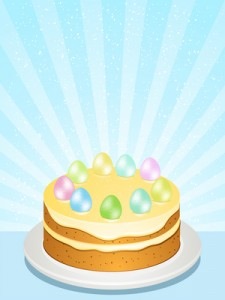 Oh, those pretty chocolate eggs nesting in baskets on beds of paper straw. Bunnies and ducks in all shades of chocolate. Brightly wrapped candy stuffed in plastic eggs for Easter egg hunts. Chocolate smeared over little kids’ faces and indestructible peeps molded into weird shapes before being popped in the mouth.
Oh, those pretty chocolate eggs nesting in baskets on beds of paper straw. Bunnies and ducks in all shades of chocolate. Brightly wrapped candy stuffed in plastic eggs for Easter egg hunts. Chocolate smeared over little kids’ faces and indestructible peeps molded into weird shapes before being popped in the mouth.
It’s Easter candy time. Face it – admit it – Easter candy is seductive. I dare you to eat one jelly bean or unwrap and savor just one brightly colored mini-chocolate Easter egg.
If you’re going to indulge — and sometimes it’s worth it — you might as well know a little about your chocolate Easter candy so you can factor their caloric punch into your eating plan.
Easter Eggs – the Confectionary Type
They’re everywhere and at every price point. Some are piped with flowers and others are wrapped in foil. You find them in chain stores, discount stores, and at high end chocolatiers. Easter is the second ranked holiday for candy purchases in the United States (just behind Halloween) and solid, hollow, and filled chocolate Easter eggs are one of the most popular choices.
John Cadbury make the first French Eating Chocolate in 1842 but the first Cadbury Easter Eggs didn’t arrive until 1875 and were a far cry from today’s Cadbury Crème egg (which now also comes with caramel, chocolate, and butterfinger filling). Cadbury Dairy Milk Chocolate appeared on the market in 1905 and helped boost the sale of chocolate Easter eggs. Today’s chocolate Easter eggs are predominantly milk chocolate and include solid, hollow, decorated, and filled eggs.
Calories in Popular Types of Chocolate Easter Eggs
Chocolate is a high calorie, high fat food. Some of the most popular chocolate eggs:
Hershey’s Cadbury Chocolate Crème Easter Egg: 1 egg (39g), 180 calories, 8g Fat (5g saturated), 25g Carbs, 2g Protein
Hershey’s Cadbury Crème Egg, original milk chocolate with soft fondant crème center: 1 egg (39g), 170 calories, 6g fat (3.5g saturated), 28g Carbs, 2g Protein
Hershey’s Cadbury Mini Egg: solid milk chocolate eggs with a crispy sugar shell: 12 eggs (40g), 200 calories, 9g fat(5g saturated), 28g carbs, 2g protein
Hershey’s Milk Chocolate Eggs: 7 pieces, 200 Calories, 12g Fat (7 saturated), 24g Carbs, 3g Protein
Dove Silky Smooth Milk Chocolate Eggs: 6 eggs, 240 Calories, 14g Fat (8g saturated), 26g Carbs, 3g Protein
Dove Rich Dark Chocolate Eggs: 6 eggs (43g), 220 calories, 14g Fat (8 saturated), 26g carbs, 2g Protein
Reese’s Milk Chocolate and Peanut Butter Eggs: 5 pieces (38g), 190 Calories, 12g Fat (6 saturated), 21g Carbs, 4g Protein
M & M’s Milk Chocolate Speck-Tacular Eggs: 1/4 Cup (12 pieces), Calories: 210 Calories, 10g Fat (6 saturated), 29g Carbs, 2g Protein
Solid Milk Chocolate Easter Bunny: 2.5 oz, Calories: average 370
But Isn’t Chocolate Good For Me?
The health benefits in chocolate come from cocoa. Dark chocolate has a greater concentration of cocoa than milk chocolate. White chocolate, without any cocoa in it, is not really chocolate. Chocolate, especially dark chocolate, can be heart healthy if it replaces an unhealthy, high calorie snack, but there’s still no recommendation for the amount to eat to get the health benefits.
The Bottom Chocolate Line
Chocolate, especially dark chocolate, contains flavonols which have antioxidant qualities and other positive influences on heart health. However, those delicious, pastel wrapped chocolate Easter eggs are caloric and moderately high in fat, one-third of it the type of saturated fat that isn’t heart healthy. Extra ingredients like crème and caramel fillings can add lots of extra fat and calories. There’s no recommended serving size of chocolate to help gain cardiovascular benefits. If you’re going to choose a sweet treat, chocolate, especially dark chocolate with a high cocoa concentration, might be a healthier choice than other types of sweets. With a lot of treats – particularly treats associated with a holiday or celebration — there’s often a perceived license to indulge. If you’re going to enjoy your chocolate, plan on how much you are going to eat, try to eat it in moderation, attempt to balance out the extra calories in the days before and after the celebration, and enjoy every bit of it.
Want to know more about jelly beans and peeps?



